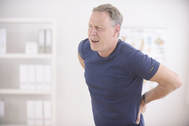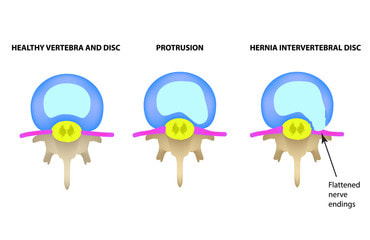|
By Dr. Jessica Warnecke PT, DPT, OCS  Everyone fears a “bulging” or “slipped” disc. What most people don’t know is that not all “bulging/slipped” discs are created the same.  There are four classifications of a disc herniation. Level 1 is called a protrusion where the nucleus pulposus (NP) is slightly pushed out of its normal boundaries but doesn’t go past the annulus fibrosus (AF). Level 2 is called a prolapsed disc. The NP is pushed further outward to the barrier of the AF but does not go through it. These first two levels are incomplete herniations. Level 3 and 4, both complete herniations, occur when the NP has passed the AF barrier. Level 3, an extrusion, completely passes the AF border, but doesn’t break through the posterior longitudinal ligament at the back of the spine. Level 4, a sequestration, has herniated to the point of breaking past the AF and the posterior ligament and can often compress a nerve, commonly the sciatic nerve, depending on the location. As awful as these might sound, it is very common for most people to have some level of disc herniation without having any pain or symptoms! A recent systematic review of literature (read more HERE) regarding disc herniation presence showed that prevalence increased from 30% to 84% as we age from 20 years to 80 years old. This entire population studied, had NO PAIN. What does this mean? Not all disc issues are painful and just because you have a herniation present, does not necessarily mean you are doomed and pain will be with you forever or until you have surgery. In fact, many disc herniations of all levels are successfully treated conservatively with physical therapy and appropriate exercises daily. Common types of low back pain present with a disc herniation include aching pain in your low back, referred or shooting symptoms down the back or side of your leg, or sharp/numbness/tingling/burning sensations down to your calf or foot if a nerve is involved. With these symptoms, you would want to avoid forward bending, leaning over to pick up something heavy, or sitting for prolonged periods. Exercises to treat these symptoms are geared at centralizing your pain- essentially reducing the intensity of symptoms lower down the leg until all your pain is localized to the low back. Then you can focus on core stability training to reduce low back discomfort and regain function. Before I reveal my go-to exercises for disc herniations, let me preface by saying that I cannot fully know without evaluating you if you actually have a herniation. And even if you do, certain physical tests we as physical therapists perform, help us know which disc and nerve involvement you are dealing with in order to best prescribe exercises. My top exercises for low back pain and disc herniations presented below are for the most common type of posterior herniation in which the body favors extension (leaning backward instead of forward). 1. Repeated extension (prone) For this exercise, you will lie on your stomach propped up on your elbows. You will slowly press up with your arms to arch your back while keeping your hips on the ground. Perform to a comfortable range, relax back down to start, and repeat. Perform 10 times. You will notice as you do more repetitions, you are able to arch further backward without feeling pain. I recommend doing 2-3 sets of 10 in the morning and evening when in bed. *For advancing this exercise when traveling, working, etc, you can perform the same movement in standing. Place your hands on your low back, gently lean backwards in comfortable range, then return to start. Again, perform 2-3 sets of 10 every 2-3 hours. As you do more reps, you will notice increased mobility backward without pain. These exercises should make symptoms down your leg feel less intense. If you feel like your symptoms in the back region increase as your leg symptoms decrease, then you are doing it correctly. With time and consistent practice, this will help reduce the overall intensity of back and leg pain. 2. Supine bridge For this exercise, you will lie on your back with knees bent and feet on the ground. Tighten your stomach by gently pulling your belly button in towards your spine. Keeping your core tight, squeeze your bottom muscles and push through your heels to lift your bottom up towards the ceiling. While keeping everything tight, slowly lower back down to the ground and repeat. Perform this in a pain free range, 10 times, 2-3 sets a day. 3. Sciatic nerve glide For this exercise, you will lie on your back. Place your hands behind the knee of your symptomatic leg. The first step involves slowly straightening your leg as far as is comfortable. Second, pull your toes towards your head. You should feel an increase in tension through the back of your leg. Step three, relax your foot. Lastly, lower your leg back down to starting position. This exercise is geared at reducing the nerve tension that causes the pain to radiate down your leg. It is important to not push through the pain when doing this exercise. Go up until you reach a tolerable point, then relax out of the motion. As noted before with the press ups, as you do more repetitions, you will notice reduced pain and tightness in the back of your leg. This exercise is great to do often throughout the day. Set a goal of 3 sets of 10 reps 3-4 times each day or as symptoms persist. It’s also not a bad idea to do this exercise on both legs. Give these exercises a try and hopefully gain some relief right away. If you still feel like you need additional help, get a consult with an orthopedic physical therapist who is specially trained in evaluating the musculoskeletal system and treating back pain. Stay tuned for our next post where I will discuss my top three exercises for low back pain due to the general demands of life and aging.
3 Comments
8/18/2021 03:53:30 am
Thanks for sharing this informative blog. The great majority of disc issues resolve without the need for surgery. Most people can return to normal function in a short period. In Neuro Wellness Care Services a Bangalore Spine Specialist Clinic, you will get the best treatment for problems related to spine by dedicated Spine Surgeons in Bangalore and the best Back Pain Treatment in Bangalore as well. For any further informations on slipped disc you may visit this article : https://bit.ly/3AIlFCG
Reply
10/5/2022 03:04:26 pm
I love how you point out that herniated discs can have varying levels of pain and are treated in different ways. My dad has been complaining about back pain recently and we have no idea what could have caused it. We've been looking into herniated discs and seeing if this is what his pain is and how we can help fix it.
Reply
Your comment will be posted after it is approved.
Leave a Reply. |
Meet Your TherapistJessica has been in Austin, TX for the past four years. She grew up in Idaho and attended PT school at Idaho State University. She completed an Orthopaedic Residency and became a Board Certified Orthopaedic Clinical Specialist in 2016. Archives
February 2022
Categories
All
|






 RSS Feed
RSS Feed